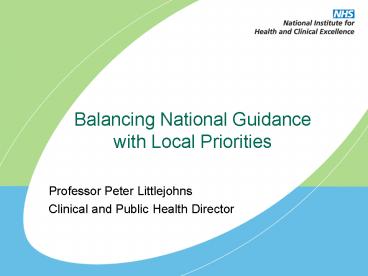Balancing National Guidance with Local Priorities - PowerPoint PPT Presentation
1 / 14
Title:
Balancing National Guidance with Local Priorities
Description:
Balancing National Guidance with Local Priorities. Professor Peter Littlejohns ... Clinical capacity and ambition. Users' expectations. Growth in health technology ... – PowerPoint PPT presentation
Number of Views:55
Avg rating:3.0/5.0
Title: Balancing National Guidance with Local Priorities
1
Balancing National Guidance with Local Priorities
- Professor Peter Littlejohns
- Clinical and Public Health Director
2
Presentation
- General context
- Benefits and limitations of national guidance
- Challenges and solutions
3
Making health policy is challenging ..
Clinical capacity and ambition
Health system objectives and resources
Users expectations
Health Policy
Growth in health technology
4
Role of NICE
- Identifies good practice using the best
- available evidence
- Helps resolve uncertainty for
- the public, patients and
- professionals
- Helps reduce variation in the availability
- and quality of practice and care
- Guidance not a reimbursement decision
- Since April 2005 has a public health remit
5
Putting the N in NHS
- People who use the NHS have a reasonable
expectation of consistent access and quality - Currently no democratic mandate for determining
local policy accountability to the people is
still through Parliament - NSFs, NICE guidance and national standards
together create a framework which both focuses
investment and helps raise standards
6
So, some important questions ..
- How explicit should the NHS be about what it
provides (and how quickly) and what it
doesnt? - What should be covered by national policy and
what should be left to local discretion? - How should the decision be made?
- Should national policy (and priorities) have the
first claim on available resources? - Who should have a say in determining local
priorities?
7
National guidance benefits and limitations
- Consistent approach to best practice
- Broad professional support
- Credible engagement with patient and public
organisations - Robust guidance through well-researched process
and methods - Resources to do the job properly
- Limitations on local professional ownership
- Implementation success dependent partly on local
agenda - Drives resource consumption without local budget
accountability - Development timelines may delay local service
development
8
NICE undertook 2 studies on National versus local
Prioritisation
- A questionnaire was sent to all DPHs in England
asking about the influence of NICE on local
prioritisation in 2000. (Views of Directors of
Public Health about NICE Appraisal Guidance
results of a postal survey. Davies E, Littlejohns
P. Journal of Public Health Medicine
200224319-325) - A questionnaire was sent to all DsPH of PCTs in
England in the spring of 2003. The questionnaire
asked about local priority setting the
development of the Local Delivery Plan (LDP)
influences on national priority setting
influences on local priority setting
displacement of local priorities by national work
programmes and details of any foregone
priorities ( formed NICE submission to the
Wanless 11 report and MFPHM submission)
9
Priority setting in PCTs and formulation of the
Local Delivery Plan (LDP)
10
Methods used to identify local priorities in PCTs
11
The relative influence on local priority setting
of the different national work programmes
12
Challenges and solutions
- Getting local support for national guidance
- Balancing funding for local initiatives and
implementing national guidance - Under-developed methods and process at local
level - Sharing expertise to ensure good quality local
and national guidance
13
Solutions (1)
- Shared ownership of the national agenda
- National guidance should deal with generally
shared and agreed - priorities (major causes of
morbidity and preventable mortality investment
and disinvestment decions) - Some local discretion on the sequencing of
national guidance in relation to local priorities
14
Solutions (2)
- Both local and national guidance/initiatives
should have full resource impact assessment - A degree of funding protection for local
initiatives - Possibly a national resource (?at NICE) to
support evaluation of local priorities































